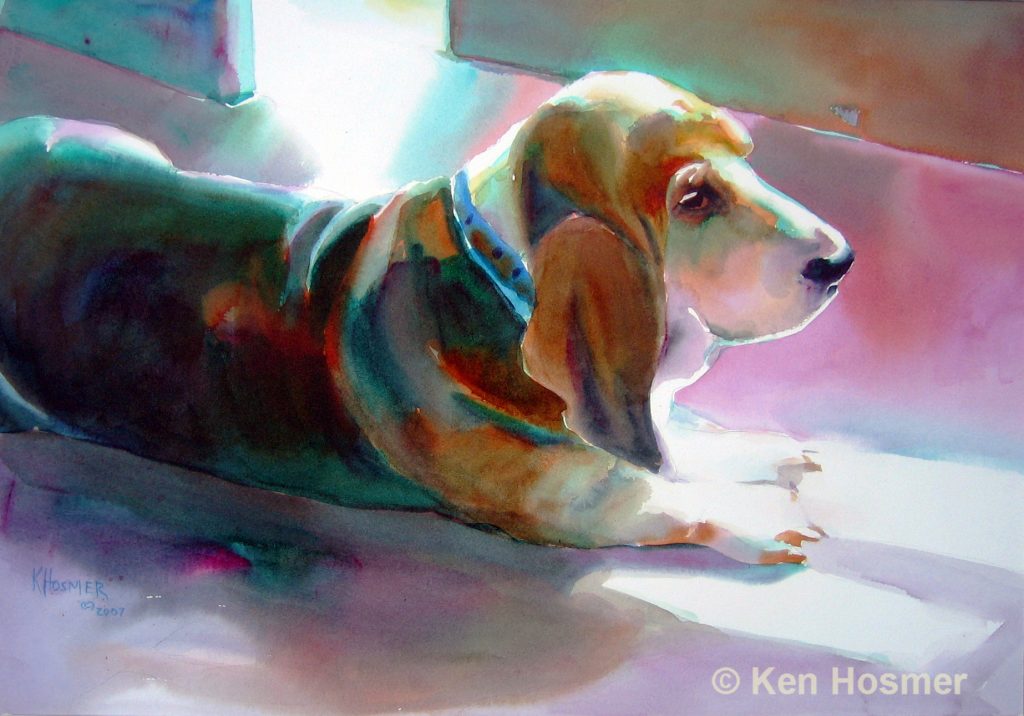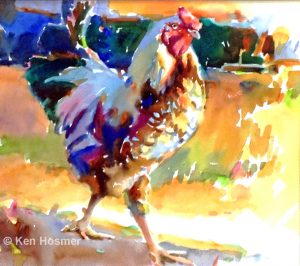
Energize Your Animal Paintings!
As an artist, I take great joy in colorfully portraying animals with a sense of movement and mood. I personally find this subject an exciting challenge.
Here, I present a short video of favorite paintings, followed by helpful tips to spice up your animal paintings.
Featured Image:
'Mister Personality'—watercolor painting by Ken Hosmer
Animals in Watercolor
Helpful Tips on Painting Animals
Utilize Photographs
The ideal scenario would be to hang around the barnyard for a week or two and do many sketches of animals. However, since I don't live on a farm, it would be difficult to achieve expertise with multiple animal types in a limited amount of time. Hence, I rely on my photographs. So rather than strive to become an expert at horse or goat anatomy, I simply learn to see and interpret shapes accurately. This allows me to depict any number of different animals: horses, cattle, goats, pigs, sheep, chickens, cats, or whatever. Therefore, photographs provide a valuable resource in my efforts to capture the movement and anatomy of animals.
As animals are continually in motion, it is a challenge to get photos with good body positioning. When out in the field, I take multiple photographs of my subject. I usually take a series of photos from one angle, as these will have a consistent light source. Then if the situation permits, I will shift to another side of the subject and take another series of photos. Later, I often combine several images into one painting.
Look at Shadows
As with any subject, make note of where the light is coming from. I mentally analyze animals in planes: top, front, left, right, bottom. Then I ask myself which planes are catching the light and which fall into shadow. On faces I exaggerate light side and shadow side. Note that animals have mostly curved shapes, creating many soft-edged form shadows. So in watercolor, it is important to paint quickly. I usually block in one body section of shadow, then quickly soften the shadow edge before the paint dries.
Create Movement
I don't want animals to seem frozen in my painting, but rather to have the illusion of lifelike movement. The key to creating this effect is the use of lost and found edges—especially on the outer edge of the figure. After the painting is complete, I always go back and lift or soften additional edges where the animal subject meets the background. The norm is to randomly alternate sharp or hard edges with soft or blurred edges. It is important to notice that the imagination of the viewer will recreate the missing edges.
Another way to create a lost edge, is to match the value of the background to that of the subject. This confuses the viewer's eye, creating ambiguous edges. Again, lost and found edges are the strongest tool we have to create the illusion of movement.
Simplify the Background
Manipulate the background to enhance animal subjects. I often eliminate unnecessary detail and adjust the value and color of the background to either contrast or camouflage the outer edges of animals.
If I want to camouflage the outer edge, I match the value of the background and subject. On the other hand, if I want to emphasize an edge, I create contrast with the background. Other options include using a complementary color in the background, or using a warmer or cooler color temperature in the background. For example, I might place a complementary piece of green behind a rooster's red comb to make the red appear brighter and create a stronger center of interest.

Exaggerate Color
I prefer to exaggerate color changes in animals. This adds excitement and can contribute to the mood of the painting. Subjects such as chickens or goats may develop a playful or humorous mood as the painting progresses. Lively color enhances this feeling, and animals often take on a unique sense of personality. As an artist, I find this phenomenon both exciting and part of the mystery of the painting process.
Ultimately, I want paintings of animals to feel alive and energized, with a sense of movement, color, and mood.
To Learn More:
See my watercolor demonstration, Calico Cat.
